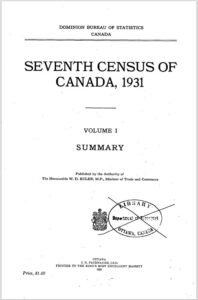26 May 2023
 Census enumerators across Canada were busy on June 1, 1931, going door to door to gather 40 fields of personal information about 10,376,379 Canadians, including family names and relationships, age, gender, occupation, employment status, racial origin and whether the family had acquired a radio.
Census enumerators across Canada were busy on June 1, 1931, going door to door to gather 40 fields of personal information about 10,376,379 Canadians, including family names and relationships, age, gender, occupation, employment status, racial origin and whether the family had acquired a radio.
Having sat in a vault for the past 92 years, the census will be released by Library and Archives Canada on June 1, 2023. According to Canada’s strict privacy laws, personal information in a census cannot be made public until 92 years after the census was completed. (In the United States, the 1950 census was released several years ago.)
Library and Archives Canada has already digitized all 234,687 pages of the census. On or shortly after June 1, 2023, Ancestry, the huge American genealogy company, will apply its state-of-the-art handwriting recognition technology to the digital images to create a full index of the entire census.
FamilySearch, the free Utah-based genealogy platform hosted by the Church of Latter Day Saints, will then review the computer-generated index to ensure a complete and accurate index of all fields. At some unspecified time hopefully in the very near future, the images and indexes will be made available and searchable online for free through Census Search, Library and Archives Canada’s new one-stop shop for national census records. The images and indexes will also be available on Ancestry.ca and FamilySearch.org.
Library and Archives Canada has enjoyed a long collaborative relationship with external organizations like Ancestry and FamilySearch to help preserve and provide access to its genealogically significant historical records.
 “The release of the 1931 Census could enable millions of Canadians over the age of 60 to find census data for their parents for the first time,” said Todd Godfrey, a vice-president of Ancestry. “For those between 35 and 49, the census offers the first opportunity to access records for their grandparents. This will be game-changing for people building their family history and making connections with their ancestors.”
“The release of the 1931 Census could enable millions of Canadians over the age of 60 to find census data for their parents for the first time,” said Todd Godfrey, a vice-president of Ancestry. “For those between 35 and 49, the census offers the first opportunity to access records for their grandparents. This will be game-changing for people building their family history and making connections with their ancestors.”
“A census entry for a household is a snapshot into Canadians’ lives in that era,” wrote Sara Chatfield, a blogger for Library and Archives Canada. “Each page tells two stories. First, it tells the story of a family: their names, ages, religion and other elements of their identity. Second, the entry gives the context of their story within Canada: their neighbours, home, occupation, employment status and community.”
The 1931 Census of Canada was the seventh comprehensive 10-year census following Canada’s Confederation on July 1, 1867. Its release has been a greatly anticipated event by the wider genealogical community across Canada, as well as by many international researchers who have ancestors who lived in Canada at that time. ♦
Post-script (June 20, 2023): The census is now on Ancestry – go to https://www.ancestry.com/search/collections/62640/







